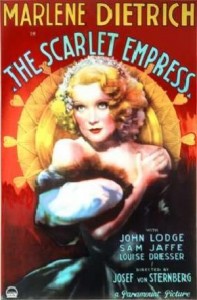The Reigning Beauty of the Screen!
Josef von Sternberg and Marlene Dietrich were one of the most productive and frequent parings in Hollyood history, and especially so in the early years of the genre. In fact, it is director von Sternberg’s almost constant erotic fixation with Marlene Dietrich which is responsible for much of her subsequent image and perception, with much of that perception remaining to the present day.
The Scarlet Empress, released the rather busy year for Hollywood of 1934, was the sixth film in which Sternberg directed Dietrich, his favorite leading star. The subject matter is rife for a good film, being the marriage of the German Princess Sophia, played by Marlene Dietrich. (Though to be completely historically accurate, there was no unified Germany at the time.)
She is brought to Russia under the escort of Count Alexei (John Lodge) to marry the crown prince of Russia, Grand Duke Peter, played by Sam Jaffe. On her arrival she realizes that her only duty is to provide a male heir via Peter, whom his own mother terms a “half wit.” Marrying him but refusing to consummate the marriage, Sophia has numerous other amorous conquests, one of which does result in an heir. Becoming aware of Peter’s intrigues against her, she ultimately assumes the throne as Catherine the Great.
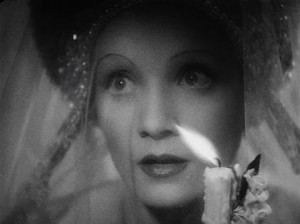 Marlene Dietrich herself is fine here, though she is given little to do outside of wear a bevy of exotic costumes and pose for long atmospheric shots of her. Initially she presents herself as a wildly overwhelmed little German girl, full of wide eyes and surprises. Although these never come across as sincere, as she becomes more familiar with the Russian court she comes into her own.
Marlene Dietrich herself is fine here, though she is given little to do outside of wear a bevy of exotic costumes and pose for long atmospheric shots of her. Initially she presents herself as a wildly overwhelmed little German girl, full of wide eyes and surprises. Although these never come across as sincere, as she becomes more familiar with the Russian court she comes into her own.
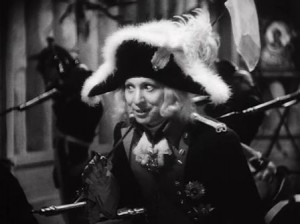 Sam Jaffe for my money almost steals the show as the Grand Duke Peter. He comes across as a mindlessly grinning idiot who is more interested in his toy soldiers and mistresses than Catherine or the country. In one scene straight from a Marx Brothers film, (he’s really a misplaced Harpo Marx perhaps) he drills a hole through a wall to spy on Catherine speaking with his mother.
Sam Jaffe for my money almost steals the show as the Grand Duke Peter. He comes across as a mindlessly grinning idiot who is more interested in his toy soldiers and mistresses than Catherine or the country. In one scene straight from a Marx Brothers film, (he’s really a misplaced Harpo Marx perhaps) he drills a hole through a wall to spy on Catherine speaking with his mother.
Sounds like a good story but Sternberg fails to let the plot slow down the veritable plethora of images of Dietrich. But what we lack in plot is made up for in atmosphere. We don’t get to see much of Russia or her people, as the film is set almost entirely indoors.
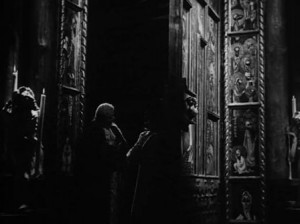 And Sternberg’s Russia evidently is a land of grotesque giants, as all the furniture is grossly over-sized, doors take a half dozen men to open, and gargoyles and other monstrous carvings abound. Sadly in many ways Dietrich becomes just another prop, so heavy handed is her director’s fixation on her.
And Sternberg’s Russia evidently is a land of grotesque giants, as all the furniture is grossly over-sized, doors take a half dozen men to open, and gargoyles and other monstrous carvings abound. Sadly in many ways Dietrich becomes just another prop, so heavy handed is her director’s fixation on her.
She is photographed from most every angle and through a few objects too, like veils and the like. Yet she seems always strangely distant from her fellow actors on screen. Whether this is intentional or not is unclear but her interactions with others seem strained and forced.
Scenes in which Dietrich isn’t featured come and go briefly and don’t seem to have been given more than a passing thought when filmed. There are a few exterior crowd scenes, where the crowd appears and disappears for no apparent reason and without any further comment.
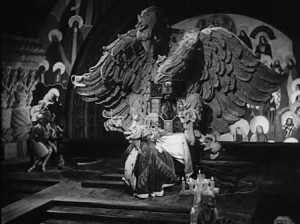 Sadly, in 1934 America didn’t want what The Scarlet Empress had to offer. Depression era audiences wanted humor to distract from the economic times, thus the success of It Happened One Night and the numerous W.C. Fields films of the year. In spite of its visual opulence, The Scarlet Empress wasn’t a success at the box office and has since been a slight cult classic.
Sadly, in 1934 America didn’t want what The Scarlet Empress had to offer. Depression era audiences wanted humor to distract from the economic times, thus the success of It Happened One Night and the numerous W.C. Fields films of the year. In spite of its visual opulence, The Scarlet Empress wasn’t a success at the box office and has since been a slight cult classic.
The Scarlet Empress deserves a better status than that. Though from a storytelling aspect there is much to be desired, the visuals and Sternberg’s central focus on Dietrich are worth the time. Dietrich perhaps was never filmed by anyone in a better way.
